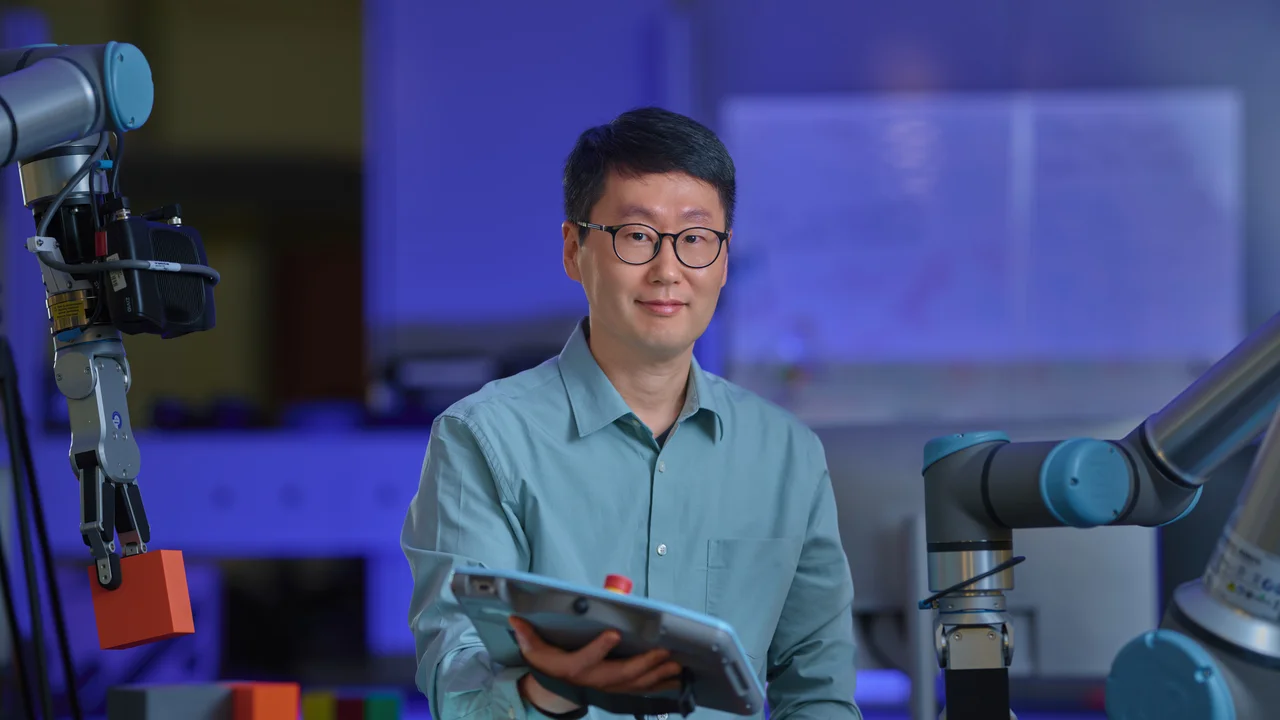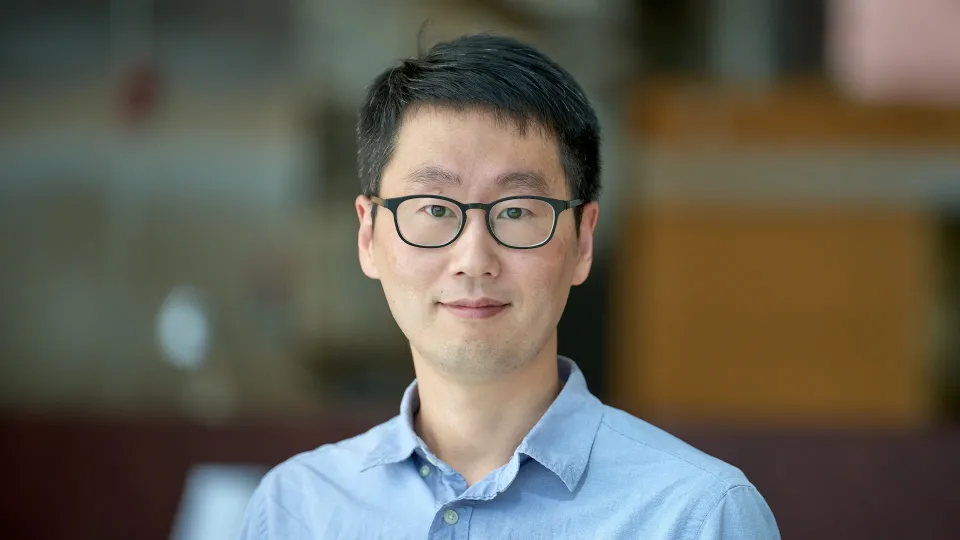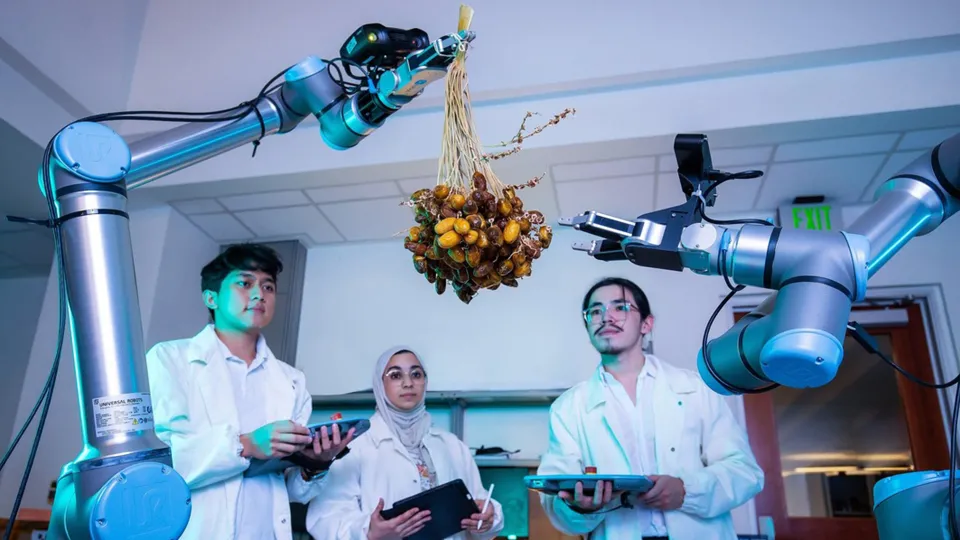
Advancing robotics for a safer, smarter future
From smart manufacturing to marine monitoring, KAUST Assistant Professor Shinkyu Park is powering Saudi Arabia’s robotics and automation ambitions
About
Autonomous systems glide through the Red Sea, mapping fragile coral reefs and identifying stress patterns across vast underwater expanses. Hundreds of kilometers away, robotic technologies are being developed to support precision agriculture, improving how crops are monitored and harvests planned. KAUST Assistant Professor Shinkyu Park and his team work across these domains, advancing technologies that sense, decide and act independently where machines can take on what is too dangerous, demanding or risky.
Park’s group builds solutions that integrate perception, control and decision-making to enable reliable, autonomous performance in diverse operational settings, from a single robot on a factory line to coordinated swarms surveying vast ecosystems.
The challenges of true autonomy
"The applications extend well beyond the lab," Park notes. "Robots can take on the three D's, the jobs that are dirty, dangerous or difficult, and perform them with precision and consistency. They can operate in places that are inaccessible or hazardous for people, such as deep underwater or inside industrial zones. In agriculture, they can automate harvesting and crop monitoring to improve productivity and environmental stewardship."
To bring this vision to life, Park and his team are addressing two central challenges in their research. The first is connecting a robot's "body", including its sensors, motors and mechanical structure, with its "brain", the software that perceives and interprets the world. Achieving this connection requires seamless communication between hardware and algorithms so that robots can sense their surroundings, process information and act safely and intelligently in real time.
The second challenge is building practical frameworks, or "playbooks," that engineers can use to design teams of robots capable of working together effectively. These frameworks define how robots plan, move and share information, ensuring that groups of machines can coordinate their actions, whether monitoring coral reefs, assembling components or performing complex tasks in dynamic environments.
Powering Saudi Arabia's digital leap
"Saudi Arabia is investing heavily in robotics and AI as part of its digital transformation," Park emphasizes. "Our work at KAUST supports this national vision by developing reliable systems that can adapt to challenging real-world conditions.”
His team's projects reflect key Saudi Arabia's Research, Development and Innovation (RDI) priorities. The team's environmental monitoring systems support the Sustainable Environment and Supply of Essential Needs pillar by providing accurate, real-time data from marine and coastal ecosystems. Their work in precision manufacturing advances the Economies of the Future through safer and more efficient production methods. In agriculture, the group's intelligent robots help farmers address labor challenges and improve efficiency, also contributing to food security as part of the Sustainable Environment and Supply of Essential Needs pillar.
In the near term, Park envisions robots becoming dependable tools that people can trust to perform tasks safely and consistently. Over time, he expects them to take on complex jobs independently, working alongside humans in ways that expand what society can accomplish.
"What makes KAUST unique is how easily collaboration happens here," Park points out. "The ecosystem accelerates impact by bringing together experts and resources in one place. Centers of Excellence such as the Generative AI Center and the Sustainable Food Security Center connect specialists in AI, plant science and engineering, creating opportunities to test robotic systems in authentic environments like agricultural farms in Saudi Arabia. The Marine Science Program also provides us direct access to natural ecosystems in the Red Sea, and the core labs provide the facilities to turn ideas into functional systems. With all these elements working together, we can move from concept to prototype to testing faster than almost anywhere else."
Building local expertise is a critical component of Park's work. As Saudi Arabia advances its Vision 2030 strategy for automation and the digital economy, developing human capital in robotics is not just an advantage – it is essential. Through teaching and curriculum design, he helps prepare the skilled workforce driving Saudi Arabia's growing robotics and technology sectors. "Educating the next generation of innovators is one of the most meaningful parts of my work," Park adds.
Through these efforts, Park’s research advances both the science and practice of robotics, strengthening the Kingdom’s capacity for innovation and position KAUST as a key player in building the technologies, talent and infrastructure driving Saudi Arabia's digital transformation.
The unexpected path to discovery
Park's journey into robotics reflects the curiosity that drives innovation at KAUST. "I didn't set out to become a roboticist," Park says. "As an undergraduate, I enjoyed building engineering systems, but robotics was not even part of the regular curriculum. Then, early in graduate school, I found myself in a robotics lab, and everything changed."
Watching a machine respond to its surroundings with a degree of independence revealed a complex challenge that captured his curiosity and soon became a long-term pursuit. During his Ph.D., Park joined a project on networked robotic systems for wildlife monitoring. These were not mobile robots but connected units that decided what to observe and when. The experience revealed how robotics could play a vital role in studying complex ecosystems and guided his path toward autonomous systems research.
A future built for a better world
Looking ahead, Park believes that progress in robotics depends on a strong foundation of fundamental research. His long-term vision is to help establish KAUST as a global hub for robotics and to build scalable capabilities that combine skilled talent, open research methods and reliable systems. "Although the University is young, it has the infrastructure, support and ambition needed to achieve that," he says. "I want to see KAUST-developed robotic technologies operating across industries, exploring, protecting and improving the world around us."
"I imagine systems that can monitor environmental changes, collect reliable data in extreme conditions and one day assist in restoring natural habitats," he concludes. "Building those capabilities, and training the people who will advance them, is how I hope to contribute to a safer, smarter and more sustainable future—a future built for a better world."

